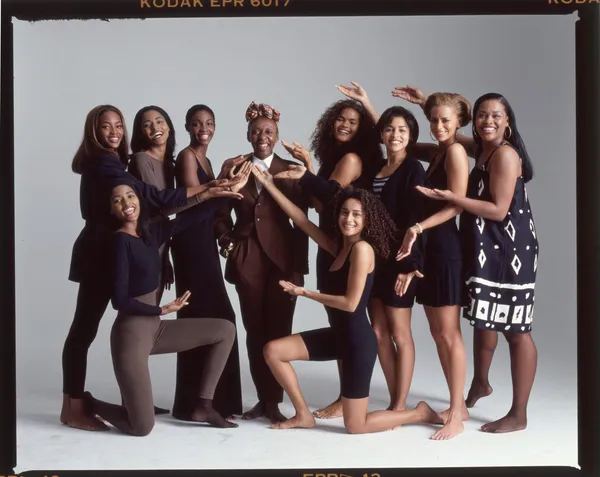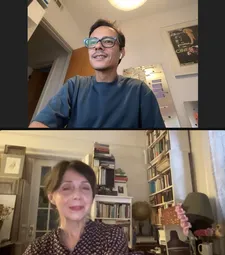When I spoke with Tribeca Film Festival Artistic Director Frédéric Boyer on Zoom from Paris, months before the 22nd edition, he noted Frédéric Tcheng and Bethann Hardison’s Invisible Beauty (produced by Lisa Cortes of Harold Crooks and Judd Tully’s The Melt Goes on Forever: The Art & Times of David Hammons) as one of the highlights to see and commented: “We play all the films by Frédéric Tcheng (Halston and the World première of Dior And I). He’s a great person, very elegant.” Frédéric also co-directed Diana Vreeland: The Eye Has To Travel with Lisa Immordino Vreeland and Bent-Jorge Perlmutt and was a co-editor with Bob Eisenhardt for Matt Tyrnauer’s Valentino: The Last Emperor.
Bethann Hardison (model, agency founder, activist) seen in Roger Ross Williams and Larissa Bills’s The Super Models series (on Naomi Campbell, Cindy Crawford, Linda Evangelista and Christy Turlington, 2023) was a consulting producer on Fritz Mitchell’s The Battle at Versailles (where she was one of the models in 1973) and she was featured along with Isabella Rossellini, Christie Brinkley, Marisa Berenson, Pat Cleveland, China Machado, Beverly Johnson, Carmen Dell'Orefice, Carol Alt, Cheryl Tiegs, Paulina Porizkova, Jerry Hall, Karen Bjornson, and Christy Turlington in Timothy Greenfield-Sanders’ About Face: Supermodels Then And Now (2012).
Invisible Beauty looks clear-eyed at the omnipresent racism. The excuses why so few models of colour were chosen for so many years range from “different make-up” that is necessary to “they make the clothes look different.” Statements like these don’t disappear and Bethann Hardison felt in the early 2000s that what she had accomplished earlier, was being erased.
A few days ago, chief fashion critic of The New York Times, Vanessa Friedman, in an article titled Fashion’s Groupthink Problem - Why is the industry going backward when it comes to diversity and designers? diagnoses the status quo. Six new creative directors of major fashion labels - all white males with similar professional backgrounds and aesthetic - could easily be cast as brothers in a movie.
Bethann Hardison has been fighting the battle against sameness in the fashion world throughout her career. She says she owes it to her community to leave a memoir behind, and we see her typing “Looking back to go forward.” This is precisely the objective of the documentary, and the thrill of it as well. Time moving forward does not necessarily mean progress, and as is clearly shown, progress in representation, in diversity, can easily be reversed with new fads and trends. We hear about her childhood’s eclectic influences. Bruce Weber calls her “like a big sister” and “this skinny kid with a gorgeous face and a presence, even then.”
 |
| Bethann Hardison backstage at the Battle of Versailles in 1973 Photo: Jean-Luce Huré, courtesy of Magnolia Pictures |
As a runway model it was samurai movies that influenced her walk and gave her inner strength to conquer the fear. Black power, civil rights - Bethann used her platform, or rather built her platform in fashion circles to educate the world, a world that needs to get dressed every day. She participated in the famous Battle of Versailles, where American designers and a dozen Black models clearly outshone the French establishment. She became assistant to designer Stephen Burrows and by founding her own modelling agency in 1984, she helped the careers of Iman, Naomi Campbell, Tyson Beckford and many others.
Vogue Italia’s Black issue (which sold out three times) that she worked on together with Franca Sozzani was one way to challenge the status quo. “I’m trying to educate white people,” she says, and “I have no dreams, I have objectives.” This extraordinary documentary, assembled with humour and style, makes us reflect on the structural changes that still need to happen. Or, as Audre Lorde said: “It is not our differences that divide us. It is our inability to recognise, accept, and celebrate those differences.”
Anne-Katrin Titze: Good to see you!
Frédéric Tcheng: Hi, good to see you too! Thanks for taking the time.
AKT: Of course! This is our third film conversation, first time on Zoom. Your film starts with many details to see. A hotel room and sunglasses and roses and we hear a harp and Bethann is called the godmother of fashion and there’s Whoopi Goldberg and boxes of stuff and looking back to go forward. And then comes her question: “How shall we start the film?” It’s funny because you have already told so much!
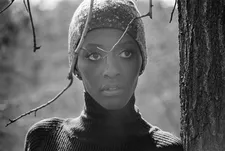 |
| Bethann Hardison photographed by Bruce Weber Photo: Bruce Weber, courtesy of Magnolia Pictures |
FT: The beginning of the film came in different stages. You know, when I did start writing the film, our producer Lisa Cortes, she was like “I think it would be a good exercise for you to start writing a little bit how you see the film. And I did write this first scene where we talk about how to start the film and see glimpses of Bethann’s life, flashes of archival footage, and Bethann reflects on how to present herself, where to start the story. At the root of what I wanted to do was to make a portrait of Bethann but also make a reflection on what is a portrait. How do you tell one story and what is a film, also, what is a biographical film? The genre has become so widespread, there are a lot of conventions.
And I wanted to break those conventions and do something a little different and maybe interrogate the conventions. That scene, where to start the film, was the first part. Then when we got to the editing room, we had a problem that many filmmakers have, which is, we had several beginnings. We had a beginning where we had this conversation, but we also had a beginning where we meet Bethann and people tell us who she is, and we also had a beginning where she starts organising her archives.
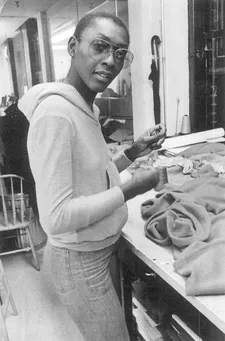 |
| Frédéric Tcheng: “She’s been such a great mentor to many people and has really made a profound impact. ” Photo: Ming Smith, courtesy of Magnolia Pictures |
It was a real challenge actually to weave together all these beginnings. And it came at the last minute, you know, Bethann going through the boxes and intercutting that with the voices of people talking about how important she was - that came during the last month of editing. The last thing we shot. I did some pickups of those boxes being opened.
AKT: It’s also beautifully symbolic because the box that is opened is the box of diversity in the fashion industry. You show it in the structure of the film that boxes also can be closed again. Bethann opened boxes wide, but then a decade later others came and closed the boxes again.
FT: I think you’re totally right. Part of the film was also about shining a light on a history that has been told, really, and that has been forgotten. Who really remembers the fact that the Eastern Europeans became such a trend that the Black models disappeared in the late Nineties or early 2000s? Nobody remembers that! Even people in fashion. So I think it’s really important to see what Bethann did and the historical movement she created. Now we just see diversity and that’s great and we need to celebrate that, but we also need to know where it came from.
AKT: We know more about the Battle of Versailles than we know about that backlash. It’s quite recent and not spoken about.
FT: Yeah. The Battle of Versailles - Bethann would always say it’s only recently, six to ten years ago, that it was rediscovered. I think The Metropolitan Museum’s diversity department decided to honour the women who were at Versailles and rediscovered this event and honoured them at a ceremony. And Robin Givhan started writing a book - she is in our film.
AKT: I noticed.
FT: And there were two documentaries made about it. But there was a long period where the Battle of Versailles was forgotten as well.
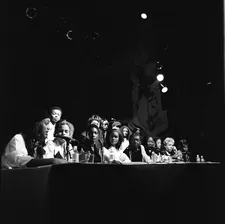 |
| 1992 Black Girls Coalition Press Conference Photo: Keith Majors, courtesy of Magnolia Pictures |
AKT: And last year Tom Ford had the big installation about it at The Met for the Costume Institute’s In America: An Anthology of Fashion? exhibition. Did you like it?
FT: I loved it! I like the crazy kind of samurai …
AKT: I did too! And you’re giving me the perfect segue. One of my favourite moments in your film, one of the most inspiring ones that I kept thinking about, is when Bethann says that she thinks of being a samurai in difficult situations one has to walk through. “The way you walked and the will not to have fear,” she says.
FT: Yes, that was one of my favourite moments, too. It’s so nice when you start weaving those moments together. When things come together in such an organic way. I knew that Bethan had that samurai comparison or inspiration. She had told me a long time ago. But then I interviewed Donald, the father of her child, her best friend when they were growing up.
He told me when they went to the West Village when they were young, to get out of Brooklyn, they would go see all the foreign films. They’d go to the arthouse films and the samurai films, those were especially something that they loved. They felt the affinity, I guess, when he talked about seeing the Asian guy kicking. What did he say? “For once it wasn’t the white guy who was doing all the kicking.”
AKT: I also loved how you were treating her childhood. Because the two of you were co-directors, Bethann had a lot of input, I suppose. There’s a clip of Fred and Ginger and her cheerleading and the tap-dancing that we see and the jitterbug. It gives a different energy than so many films who sombrely tread into the subjects’ past.
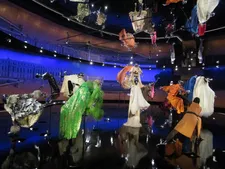 |
| Tom Ford’s Battle of Versailles in the Costume Institute’s In America: An Anthology of Fashion at The Metropolitan Museum of Art Photo: Anne-Katrin Titze |
FT: I love that you say that! That’s who Bethann is; she drew inspiration from unconventional places. And I loved translating that into film. You have Fred and Ginger dancing in Top Hat and the next image is the gangs in Brooklyn. You create visually also these contrasts and show that her inspirations were very varied. Just like her mom and dad were very different. The mom was like the party girl, she had a great sense of humour and she had style. And the dad was more the intellect.
AKT: He became an imam when she was 12, didn’t he?
FT: Yes, he became an imam, so he was a religious leader, and he really gave her an education, a sense of political consciousness.
AKT: And Malcolm X came to their house!
FT: Yes, twice! Can you believe it?
AKT: Unbelievable! As you know, I recently had a conversation with Nailah Jefferson, the director of Donyale Luna.
FT: Yes, but I haven’t seen the whole film yet.
AKT: The family background couldn’t be more different. There was domestic violence, eventually the mother shot and killed the father. Donyale, who already had left Detroit, has a nervous breakdown and then moves from New York to Europe. Bethann also says the place of growing up is “both foundation and limitation.”
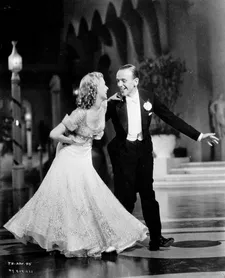 |
| Invisible Beauty has a clip of Ginger Rodgers and Fred Astaire in Mark Sandrich’s Top Hat |
FT: She has a way with words. That’s real wisdom. She just comes out with phrases like that, that are just very profound. It’s true, she was always struggling with her place of origin, which was very foundational, and she will always be from Brooklyn. At the same time she knew that she had to leave. She comes out with these one-liners that are so powerful.
She had to break free; she says that at one point. She didn’t know what she needed to break free from. She also comes back to this theme when she talks about her father bringing back her stuff to her mom and grandmother’s house. She says “I knew I couldn’t have it both ways - the freedom or his good opinion.” There’s always this tension where you come from and where you’re going.
AKT: And her understanding of that, I think, was why she was such a great help to so many people. Iman says that she met Bethann right when she came from Kenya and that she was the first person who said “Welcome to America!” Also Naomi Campbell says that she met Bethann at 15 when she was still new to the industry and encountering its racism.
FT: She’s been such a great mentor to many people and has really made a profound impact. The striking thing when we were interviewing all the participants, they were so emotional and they had so much attachment and admiration for Bethann. She really touched their lives in a very particular way. I understand because now I’m part of that circle. She really has kind of mentored me in a way while we were making the film but even more since we finished it. She has a way of becoming a very important part of your life.
AKT: She worked with Franca Sozzani on the famous Vogue Italia Black issue in 2008!
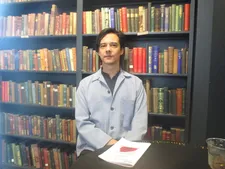 |
| Frédéric Tcheng: “Invisible Beauty for me was a pivotal film, because it makes that link between fashion and politics and representation very clear.” Photo: Anne-Katrin Titze |
FT: Yes, Franca Sozzani was a big supporter of what Bethann was doing and I know that they were close and when Bethann started noticing the changes in the industry and started to go public and had those press conferences, Franca Sozzani was one of the allies who decided to do something about it with their tools.
And she did this Black issue that is such a cult issue. I remember interviewing - we didn’t put it in the film eventually - but we interviewed Liya Kebede and Aurora James and they both said that the Black issue was like a collector item - they heard about it and they wanted to buy it and it made a big difference for especially girls of colour.
AKT: How is Bethann’s memoir coming along?
FT: She’s been writing this summer a little bit and she has a deadline of the end of the year to finish the book. I think it was hard to do at the same time, the film and the book. Now it’s time to finish it.
AKT: And you? What’s coming up?
FT: I’ve been developing a couple of projects. I’m excited to go in a new direction.
AKT: Is it still somewhere in the fashion field?
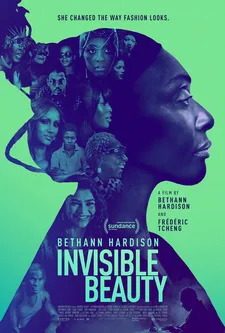 |
| Invisible Beauty poster |
FT: There’ll be both. There may be some stories that have something to do with the fashion world but it’s not really about the fashion. For me it’s always about the people and the human beings and the human story. But I’m also developing something that is more political.
AKT: I think it always is. It’s something many people overlook, that fashion is political because it concerns us all every day.
FT: Absolutely! That’s why Invisible Beauty for me was a pivotal film, because it makes that link between fashion and politics and representation very clear. What you see has an effect in the world and Bethann says it very beautifully. You know, she was trying to affect more than just the fashion industry, she was trying to affect society. Because she realised it’s a visual world we live in and the fashion model was the tool she had in her shed but she was really reaching for a bigger change.
AKT: A change also behind the camera, so that it is not only the model but the entire industry embracing more diverse representation.
FT: And also just representation on a very simple level. As she says, everybody says “Thank you for helping the Black model.” But she’s trying to educate white people. In that context, representation is important because she knew that if people are used to seeing more people of colour in the magazines, on the billboards, in the advertisements, then they’ll start being more used to it. It becomes more normal and less of a separation. It’ll be a more integrated world visually and then what is in front of you visually affects the way you see the world.
AKT: Perfectly put! Lovely to see you!
FT: Great to see you, too! Talk to you soon!
Invisible Beauty will be available on Video on Demand starting Tuesday, October 31.








